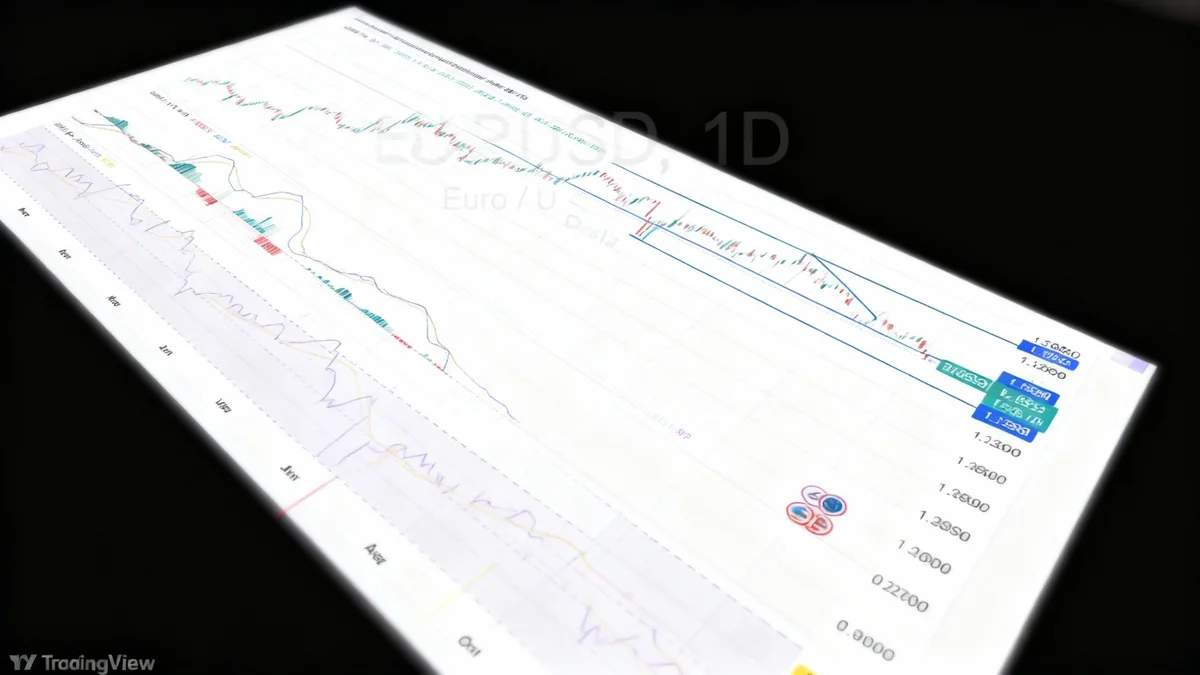The Euro is facing sustained selling pressure against the U.S. Dollar, pushing the EUR/USD currency pair toward the critical 1.1400 support level. This movement comes as traders assess differing monetary policies from the European Central Bank and the U.S. Federal Reserve, with upcoming U.S. economic data expected to provide further direction.
The 1.1400 mark is not just a psychological barrier; it represents a significant technical convergence that has historically influenced the market's direction. A definitive break below this level could signal the end of the uptrend that began late last year.
Key Takeaways
- The EUR/USD exchange rate is in a bearish trend, approaching the major support level of 1.1400.
- This level is significant as it aligns with the 200-day Exponential Moving Average (EMA), a key long-term trend indicator.
- Diverging central bank outlooks, with a neutral ECB and a cautiously dovish Fed, are influencing currency valuations.
- Upcoming U.S. ISM PMI data will be closely watched for economic health signals in the absence of official government reports.
Technical Indicators Signal Further Weakness
Several technical indicators suggest that the downward momentum for the EUR/USD pair may continue. The price recently fell below its 100-day Exponential Moving Average (EMA), a move often interpreted by analysts as a sign of increasing bearish sentiment.
Further supporting this view is the Relative Strength Index (RSI), a popular momentum oscillator. The RSI is currently reading around 35, well below the neutral 50 mark, indicating that sellers are largely in control of the market. Readings below 30 typically signal oversold conditions, but at 35, there is still room for the pair to move lower before a potential reversal.
The Importance of the 1.1400 Level
The 1.1400 level has acted as both a strong support and resistance point since April. It halted a significant sell-off in late July, which was followed by a sharp rebound. Its alignment with the 200-day EMA reinforces its status as a critical pivot point for the currency pair's medium-to-long-term trend.
Should the EUR/USD fail to hold above 1.1400, it could confirm the conclusion of the upward trend that saw the pair peak at 1.1918 on September 17. Conversely, if this level holds firm, it may keep the broader neutral market phase intact and potentially trigger another rebound.
Central Bank Policies in Focus
The fundamental backdrop for the currency pair is largely being shaped by the actions and guidance of the world's two most influential central banks: the European Central Bank (ECB) and the U.S. Federal Reserve.
The ECB has maintained a relatively neutral stance, expressing satisfaction with its success in guiding inflation toward its 2.0% target. This has left the bank with little reason to introduce new policy measures or provide aggressive forward guidance, leaving the Euro without a strong catalyst for appreciation.
While the European Central Bank remains on the sidelines, the U.S. Federal Reserve's recent actions have introduced more volatility. The Fed cut interest rates last week and suggested another reduction could occur before the end of the year.
However, the central bank stopped short of a firm commitment to further easing. This initial dovish signal was followed by a market interpretation that the Fed may not be as aggressive with future cuts as previously thought, which provided a boost to the U.S. Dollar.
U.S. Economic Data Takes Center Stage
With a partial U.S. government shutdown delaying the release of official economic statistics, including the crucial monthly jobs report, markets are turning to private sector data for clues about the health of the economy. This week, the focus will be on the Institute for Supply Management (ISM) Purchasing Managers' Index (PMI) surveys.
Why ISM Data Matters Now
The ISM PMI surveys are considered reliable leading indicators of economic activity. In the absence of official labor market data, traders will scrutinize the employment components within these reports for signs of weakness or strength in the U.S. economy, which could influence the Federal Reserve's next move.
Upcoming Data Points to Watch:
- Manufacturing PMI (Tuesday): The consensus forecast is for a reading of 49.2. A number below 50 indicates contraction in the sector.
- Services PMI (Thursday): The consensus forecast is 51.0. The services sector is a larger component of the U.S. economy, so this report often carries more weight.
Analysts suggest that any confirmation of the economic stagnation hinted at in September's reports could strengthen the case for more Fed rate cuts. Such an outcome would likely put downward pressure on the U.S. Dollar, potentially providing relief for the EUR/USD pair.
Conversely, if the data shows signs of an economic recovery, it would support the Federal Reserve remaining on hold. This would likely strengthen the dollar and could be the catalyst that pushes EUR/USD below the 1.1400 support level.
Market Outlook and Trading Considerations
The prevailing sentiment is that the downtrend in EUR/USD has not yet run its course. The path of least resistance appears to be lower, with the 1.1400 support level as the primary near-term target for sellers.
Immediate resistance for any potential rallies is seen around the 1.1600 level, followed by a more significant barrier at 1.1680. A downward-sloping trend line that has capped gains since mid-September also remains a formidable obstacle for buyers.
Given the current technical and fundamental landscape, traders are closely monitoring the upcoming U.S. data releases. The market's reaction to these reports will likely determine whether the critical 1.1400 support holds or if a new, more bearish phase for the EUR/USD is about to begin.





